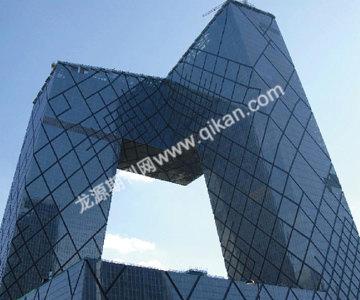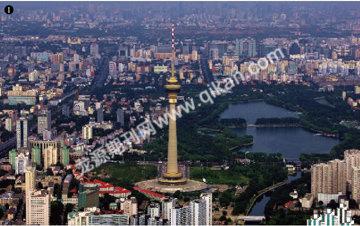Landmark Signs of the Times
By YANG BAOJUN

THE Chinese public has periodically selected over the past five decades what they believe to be Beijings ten most impressive pieces of architecture. Buildings voted “top ten” in 1959, 1988, 2001 and 2007 reflect both the changes in Chinas architectural concepts and the countrys progressive socio-economic transition.
1950s
The buildings voted Beijings top ten in 1959 were projects celebrating the tenth anniversary of the founding of the Peoples Republic of China. As such, they were also the national “top ten.” Their design, selection of building materials and actual construction were simultaneously accomplished in the ten months leading up to the tenth-anniversary celebration. The architectural concept of these buildings was open, in accordance with Premier Zhou Enlais principle, “We can adopt all good things, both ancient and modern, Chinese and foreign.” The large pitched roof of the National Agricultural Exhibition Center exemplifies traditional Chinese architecture; the Great Hall of the
People is in classic Western style; the Military Museum of the Chinese
Peoples Revolution is obviously influenced by Russian soviet architecture; and the Cultural Palace for Nationalities celebrates “new China” style. The Western economic blockade of the time limited Chinas socio-economic
development and consequently the perspective of Chinese architects,
precluding any dynamic architectural statement.

1980s
Beijings ten most admired buildings of the 1980s, selected in 1988 by 230,000 votes, are all representative of the so-called modernist style. They now appear somewhat brash. The Great Wall Hotel, with its mirrored exterior and scenic elevator, embodies the contemporary international architectural fad. The Memorial Hall of the Chinese Peoples Resistance against Japanese Aggression, the New Venue of the National Library of China and the China Grand Theater all combine modernism and Chinese tradition. The Grand View Garden is new but in a traditional style. Although Beijings top ten buildings of the 1980s demonstrate great progress in both building techniques and design, there were obvious problems at the time as regards the capitals overall architectural outlook. Beijing is a historical city, and modernization is a “two-edged sword.” Modern architecture as a result of the capitals steady internationalization gave rise to nondescript buildings that blurred its characteristics as an ancient capital.

1990s
The main criteria for selecting Beijings top ten buildings of the 1990s were, “ethnic tradition, local characteristics and epochal spirit,” with the purpose of guiding architectural design towards that more befitting an ancient capital. More than half of Beijings top ten buildings of the 1990s hence reflect the dual pursuits of “epochal sense” and “Chinese characteristics.” The New Capital Library, the Beijing Henderson Center, the Beijing New World Center and the Sun Dong An Plaza all combine modern technology with traditional Chinese architecture.
The 1990s was a period of nationwide large-scale construction. Although it provided opportunities and platforms for architects, it also left China vulnerable to the Western post-modernist architectural trend. The 1990s marked the Western worlds entry into post-industrial society, and post-modernist architecture of the time represented a rejection of modernism. This architectural transition was lost on China and its people, preoccupied as they were with the process of industrialization.
2007

The focus of the fourth public selection in 2007, entitled “selecting Beijings top ten new landmarks,” was on aspects of the cityscape that had influenced the capitals urban construction and the lives of its inhabitants since 1990. The top ten landmarks were: the National Stadium (Birds Nest), Beijing West Railway Station, the National Grand Theater, Renovated Qianmen Street, Houhai Bar Street, Third Phase of the World Trade Center, Xihuan Square, Financial Street, CCTV Headquarters Building, and Zhongguancun West Zone. Included in the top 20 buildings were the National Swimming Center (Water Cube) and Terminal 3 of the Capital International Airport. The buildings were recommended by experts and selected by 72,841 votes. But certain of these choices caused debate, especially the controversial Beijing West Railway Station. There was also argument as to whether or not Houhai Bar Street should be regarded as a new or old landmark. These discussions enriched the peoples knowledge of and interest in architecture, giving architects insight into the aesthetic sensibilities of the masses, and hence a broader frame of design reference.
Meanwhile, Time magazines 2007 list of architectural marvels of the world put Beijings National Stadium (Birds Nest) sixth, the CCTV Headquarters Building seventh and the Dangdai Moma eighth. In July of the same year Chinas Birds Nest topped The Times top ten world buildings, which also included Beijings Capital International Airport Terminal 3 and the CCTV Headquarters.
The level of attention mainstream Western media pay to Chinese architecture implies that China constitutes a suitable site with appropriate conditions for the creation of world-class architecture, including greater social openness, encouragement of avant-garde creative concepts, improved building materials and a higher technological level, greater motivation spurred by fierce competition within the building industry, the maturation of native architectural practices and increasingly frequent and routine international exchanges.
These conditions have been achieved through Beijings successful transformation from an industrial to post-industrial society, and its steadily rising status and influence within the global city network. The proportion of added value from Beijings tertiary industry in 2007 exceeded 70 percent, and the scale is still expanding. A post-industrial society like Beijing needs, and therefore supports, groundbreaking architectural creations.

